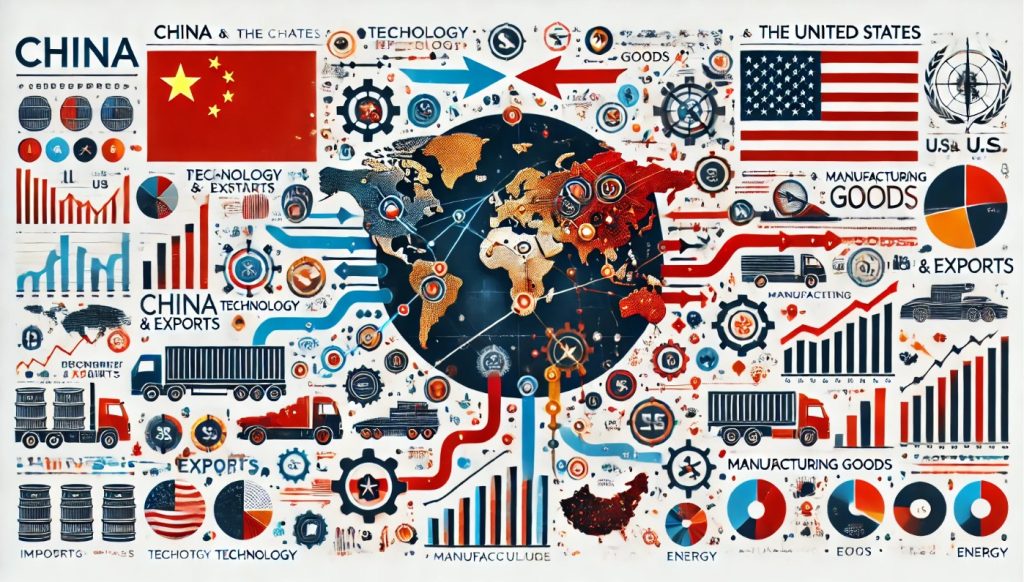The trade relationship between China and the United States is one of the most consequential in the global economy. As the two largest economies in the world, their economic interactions have profound implications not only for their own prosperity but also for global trade, geopolitics, and international relations. For decades, the trade ties between these two nations have been characterized by a mix of cooperation, competition, and tension. The nature of their trade relationship has evolved over time, reflecting shifts in global economic trends, domestic policies, and geopolitical dynamics.
The Historical Context of China-U.S. Trade Relations
The trade relationship between China and the United States dates back centuries, but it was only in the late 20th century that trade between the two countries began to grow substantially. The normalization of diplomatic relations between the U.S. and China in 1979 marked a pivotal moment in the development of their trade relationship. The liberalization of China’s economy and its entry into the global market were essential catalysts for the rapid expansion of trade.
Early Trade History: A Complex Relationship
The early trade history between China and the U.S. was marked by both trade and cultural exchanges but also significant challenges. The U.S. became involved in the China trade in the 19th century, primarily through the export of goods like opium, cotton, and textiles. The Opium Wars (1839–1842, 1856–1860) led to the opening of Chinese ports to foreign trade, under treaties that heavily favored Western powers.
For much of the 19th and early 20th centuries, the U.S. and China were not significant trading partners, and the volume of trade was relatively small compared to other global trade routes. However, the U.S. was a key player in early interactions with China, particularly after the Boxer Rebellion in 1900 and the subsequent Open Door Policy, which advocated for equal trading rights for all nations in China.
The Reform Era and China’s Integration into the Global Economy
In the late 20th century, trade relations began to take a more modern shape with China’s economic reforms under Deng Xiaoping. The Chinese government began shifting from a closed, state-controlled economy to a more market-oriented one, encouraging foreign investment and trade. The country’s accession to the World Trade Organization (WTO) in 2001 marked a transformative moment in U.S.-China trade relations. China’s membership in the WTO signified its deeper integration into the global trading system and opened new opportunities for trade with the U.S.
China’s entry into the WTO led to dramatic growth in trade with the United States. China’s manufacturing sector became increasingly competitive, and the country emerged as a global export powerhouse, supplying the U.S. with a wide range of goods, from electronics to clothing to furniture.
The Growth of Trade Between China and the U.S.
The economic liberalization of China and the opening of its markets to foreign trade created new opportunities for U.S. companies and investors. However, it also gave rise to several key issues that would come to dominate the trade relationship between the two countries.
Rapid Growth in Bilateral Trade
From the early 2000s onward, trade between the U.S. and China grew exponentially. By the 2010s, China had become the U.S.’s largest trading partner in goods, while the U.S. became one of China’s top trading partners, especially for high-tech products and agricultural commodities. This growth has been driven by several factors:
- Manufacturing in China: China’s ability to produce goods cheaply, especially labor-intensive products, allowed it to become a manufacturing hub for the world. Many U.S. companies, including Apple, Nike, and General Motors, established production facilities in China to benefit from lower labor costs and access to the vast Chinese market.
- Consumer Goods: As China’s middle class grew, so did its appetite for consumer goods. U.S. companies were eager to access this growing market, particularly for luxury goods, high-end automobiles, and entertainment products.
- Technology and Electronics: China’s tech sector, led by companies like Huawei, Alibaba, and Lenovo, began to expand globally, while U.S. companies like Intel, Microsoft, and Cisco saw massive demand for their products in China.
The trade relationship saw China exporting a wide range of products to the U.S., particularly electronics, machinery, textiles, and toys, while the U.S. exported agricultural products, vehicles, and high-tech equipment to China.
U.S. Trade Deficit with China
One of the most contentious aspects of the China-U.S. trade relationship has been the trade deficit. For many years, the U.S. has imported far more from China than it has exported, leading to a persistent trade imbalance. This trade deficit became a focal point of U.S. political discourse, with many policymakers and politicians arguing that China was benefiting disproportionately from the relationship.
The trade deficit has been a major source of frustration for the U.S., with critics claiming that it has led to the loss of U.S. manufacturing jobs and contributed to the erosion of the U.S. industrial base. U.S. workers, particularly in the manufacturing sector, have often viewed the imbalance as a sign of unfair trade practices, including allegations of currency manipulation and intellectual property theft.
Key Trade Issues Between China and the U.S.
Over the years, several key issues have shaped the China-U.S. trade relationship, from market access to intellectual property to tariffs. These issues have often created tensions, with each country accusing the other of unfair trade practices and seeking to redress imbalances.
Intellectual Property Theft and Technology Transfer
One of the most contentious issues in China-U.S. trade relations has been the alleged theft of U.S. intellectual property (IP) by Chinese firms. American companies have long complained about Chinese companies copying technology, designs, and processes, which has led to significant losses in trade and innovation. In many cases, U.S. businesses claim that they are forced to share proprietary technology and trade secrets with Chinese partners in order to access the Chinese market.
U.S. policymakers have accused China of using state-backed policies to support IP theft and forced technology transfer, especially in high-tech industries such as semiconductors, telecommunications, and artificial intelligence. As a result, IP protection has been a central issue in trade negotiations between the two nations.
Trade Imbalances and Tariffs
The growing trade deficit between the U.S. and China has also been a source of tension. In 2018, the Trump administration launched a trade war with China, imposing tariffs on hundreds of billions of dollars’ worth of Chinese goods. The tariffs were intended to reduce the trade imbalance and address concerns over China’s trade practices, including IP theft, subsidies to state-owned enterprises, and market access restrictions.
The tariffs imposed by both countries during the trade war disrupted global supply chains, led to rising costs for businesses, and created uncertainty in international markets. The trade war continued for several years, with both nations negotiating on various issues. The Phase One trade agreement signed in January 2020 resulted in some concessions from China, including commitments to purchase more U.S. goods and improve IP protections.
Market Access and State-Owned Enterprises
Another major point of contention in the trade relationship has been market access. U.S. companies have long complained that China’s markets remain closed or restricted to foreign firms in many sectors, including financial services, automotive manufacturing, telecommunications, and media. In particular, foreign companies are often required to enter into joint ventures with Chinese firms, which restricts their ability to fully own and control their operations in China.
In addition, China’s extensive network of state-owned enterprises (SOEs) has been criticized for distorting competition. These SOEs are often given preferential treatment by the Chinese government, which allows them to outcompete foreign companies in key sectors of the economy. Many foreign firms argue that these practices create an uneven playing field, preventing them from competing fairly in China’s vast domestic market.
Currency Manipulation and Trade Practices
The issue of currency manipulation has also been a recurring point of tension. The U.S. has accused China of artificially undervaluing its currency, the yuan (renminbi), to make Chinese exports cheaper and more competitive in global markets. Currency devaluation is seen as a way for China to maintain its export-driven growth model, but the U.S. argues that it creates an unfair advantage for Chinese companies.
In response to these concerns, the Chinese government has taken steps to allow the yuan to appreciate, although the U.S. continues to monitor China’s currency policies. Additionally, there are ongoing debates over the role of subsidies and government intervention in China’s trade policies, particularly in sectors such as steel, solar panels, and high-speed rail.
The Impact of Trade Policies on Both Economies
Trade relations between China and the U.S. have had a profound impact on both economies. On one hand, the trade relationship has created vast opportunities for growth, particularly for U.S. companies looking to access China’s rapidly expanding consumer market. On the other hand, tensions over issues like trade imbalances, intellectual property, and market access have led to economic disruptions and growing political pressure.
The U.S. Economy and Jobs
The U.S. economy has benefited from trade with China in several ways. The importation of affordable goods from China has helped to keep prices low for consumers, especially in sectors like electronics, clothing, and home goods. This has contributed to lower inflation rates and increased purchasing power for U.S. consumers. Additionally, American companies that manufacture in China have gained access to one of the world’s largest and fastest-growing consumer markets.
However, the trade imbalance has raised concerns about job losses, particularly in manufacturing. Many U.S. companies have shifted production to China due to lower labor costs, and this has led to the outsourcing of jobs in industries like textiles, electronics, and automotive manufacturing. The U.S. government has responded with measures to protect domestic industries, including tariffs on Chinese imports, as well as trade deals with other countries.
The Chinese Economy and Growth
China has benefitted greatly from its trade relations with the U.S. by becoming a global manufacturing hub and a key player in global supply chains. The country’s economy has grown rapidly due to its ability to export goods at competitive prices, and this trade has contributed to the rise of China’s middle class and the expansion of its services and consumption sectors.
However, the trade tensions with the U.S. have highlighted vulnerabilities in China’s trade model. Over-reliance on exports and foreign markets has made China vulnerable to tariffs, trade wars, and disruptions in global supply chains. In response, China has been working to shift its economic focus toward domestic consumption and high-tech industries like electric vehicles, artificial intelligence, and 5G technology.







